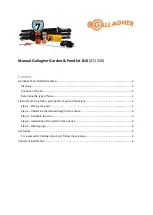
MAN - Pyrolytic Oven - REV: Original | F. Operation
27
1. After the Pyro-Clean Oven has been installed and properly vented with the correct draft, it is ready to operate.
However, it is best to run the oven through a short cleaning cycle with it empty to:
a. Familiarize the operator with the normal operating sequence and location of the controls.
b. Check that all controls, indicating lights, and components are operating normally.
2. The oven door latch is a compression type and must be turned completely to the right until the door “pulls up” and
is completely latched.
3. When the main power toggle switch is turned on, the indicator light and HMI should power up. For this test only,
set the Cycle Time on the Settings Screen to about 10 minutes.
4. To start the empty test run, press the Start Button. The status bar will change to Oxidizer Preheat on the HMI. The
oven exhaust fan will be powered at this time and you may hear a slight noise from the exhaust. A small air pump
which feeds a stream of air to the oxidizer is started at the same time. The Afterburner heaters come on and you
should see the Afterburner temperature begin to rise to its normal set point of 1300°F. Typical heat-up times for the
Afterburner to reach 1300°F is about 80 minutes. 10 minutes after the oxidizer reaches 1250°F, the status bar will
change to Oven Soak, the oven will turn on, and the door will lock.
5. During an empty run, the oven will heat up to its ramp/soak set-point, typically 900°F and control at this
temperature for the stable time of 180 minutes. Then the status bar will change to Run Cycle, the oven heat up will
continue to the normal set-point of the oven temperature controller, 950°F. When the oven temperature reaches
940°F, a timer will start for the cycle time set. When it times out, the status bar will change to Cool Down, and both
the oxidizer and the oven will shut off.
6. After the oven has cooled down to below 500°F, the status bar will change to Cycle Finished, the draft inducer,
air pump, and door lock will all turn off. At this point press the End/Stop button to finish the cycle. The door can be
opened to allow faster cooling. However, in a normal cleaning cycle for glass or metal parts, it is best to let the oven
cool down as much as possible to minimize the handling of hot parts.
F.3 Starting a Normal Load of Dirty Glasswear or Metal Parts
Tips on Loading
The glass or metal parts should have relatively small amounts of organic residues, on the order of grams to a couple
pounds. Parts with very heavy residues of combustible organic matter should not be processed in the Pyrolytic
Oven. A practical limit for the oven is in the range of 1 to 2 pounds of asphalt or other organic residues per load/
cycle.
Whenever possible, always load the parts to promote drainage of any visible residues. The oven is furnished with
a metal tray on the chamber bottom to catch molten residues which drains off the parts. This will give the best
cleaning results. Longer cycle times will virtually always be required if the contaminants are not allowed to drain out
of the parts during the pyrolysis cleaning cycle.
The Pyrolytic Oven is furnished with two racks (trays) to hold the metal parts. Both of these racks have a stainless
steel wire mesh on the bottom which holds catalyst pellets which help destroy the pyrolysis gases formed during the
cleaning cycle. Use both trays during every cycle. Both must not be left out of the oven under any circumstance. A
metal drip pan on the bottom of the oven is furnished to catch any dripping. The drain pan helps prevent any plastic
or polymer from running down on the oven floor and onto the door gaskets where the residue could cool, harden
and tear off the gasket when the door is opened. Always place any metal parts with the heaviest residues toward the
Summary of Contents for Pyro-Clean
Page 43: ...MAN Pyrolytic Oven REV Original Appendix B Wiring Diagrams 38 Appendix B Wiring Diagrams...
Page 44: ...MAN Pyrolytic Oven REV Original Appendix B Wiring Diagrams 39...
Page 45: ...MAN Pyrolytic Oven REV Original Appendix B Wiring Diagrams 40...
Page 46: ...MAN Pyrolytic Oven REV Original Appendix B Wiring Diagrams 41...
Page 47: ...MAN Pyrolytic Oven REV Original Appendix B Wiring Diagrams 42...
















































